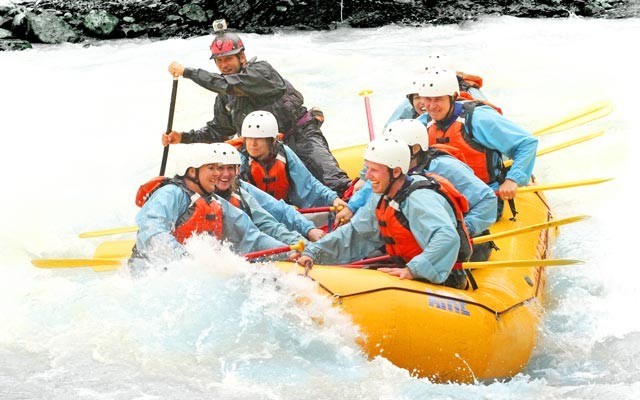If I had the choice, death by drowning would be the last way I'd want to go.
So in the days leading up to my weekend of adventure in Golden, B.C., I fretted about being tossed from a raft on my date with the Kicking Horse River.
During the safety talk enroute to the river, one of the guides from Glacier Raft Company tells us the most common accident is not being pinned against a rock, or sucked into a logjam. It's actually getting hit by the butt end of someone else's paddle in the excitement of the ride. I laugh out loud in relief until he bangs the end of his paddle loudly against the roof of the bus. Point taken.
Our first hour in the raft is strangely serene. We relax and admire the passing scenery, the mountain sides covered with evergreens and alder. The river is a pretty shade of green too, and looks harmless as it carries us calmly but steadily towards a series of narrow canyons.
We stop to hike up a short but picturesque canyon where the walls have been carved smooth by raging water every spring. The power of water is scary.
Back in the raft, the Kicking Horse begins to live up to its name. Rounding a bend, our boat twists and buckles as we careen through Portage and Shotgun, a one-kilometre stretch of river in the Middle Canyon.
I stop paddling and hold on tight — an option that's fine with our guide who yells instructions to the others from the back of the raft for the next hour. Back-to-back rapids leave us all soaked but elated. We feel on top of the world. The power of water is amazing.
Discovering the Burgess Shale
"This is sedimentary rock, there's no gold or silver here," chuckled Parks Canada guide Kristl Beetch as we hiked up Mount Stephen in Yoho National Park. In the late 19th century poorly paid railway workers hoped to improve their fortunes by looking for minerals on this mountain in their spare time.
Instead of launching a gold rush, they unleashed a fervour among geologists with something else they found — "stone bugs." Fast forward a century or so and the Burgess Shale fossil beds are designated a UNESCO World Heritage Site for the exceptional window they provide into life on earth half a billion years ago.
After climbing steadily for several hours and passing a couple of security cameras (it's usually wildlife caught on camera, not would-be fossil smugglers), we reach a large roped-off area where we're free to explore. "This is an avalanche pathway so new stuff comes down every winter," says Beetch.
It's a veritable treasure trove, with almost every piece of slate I pick up yielding one or more fossils of soft-bodied organisms — most commonly trilobites — that lived during the "Cambrian Explosion" about 500 million years ago. What makes them so significant is how exquisitely preserved they are. Beetch gives us small magnifying glasses so we can pick out the details — claws, eyes, spines — and explains that occasionally you can even see what the organism ate before it died.
We may be amateur paleontologists but we're engrossed. And so are the experts. New species are still being discovered, a dozen new ones just a couple years ago.
"This is still a happening place," sums up Beetch at the end of our hike.
If you go:
Parks Canada interpreters lead hikes to the Burgess Shale. Call 1-877-737-3783 or see www.reservations.parkscanada.gc.ca.
Glacier Raft Company offers trips down the Kicking Horse and other rivers.
Call 1-877-344-7238 or see www.glacierraft.com
For more information see www.tourismgolden.com
(Editor's note: This is the second in a series on Golden. To read the first part pick up Pique's, Sept. 4 issue, or go online to www.piquenewsmagazine.com.)




